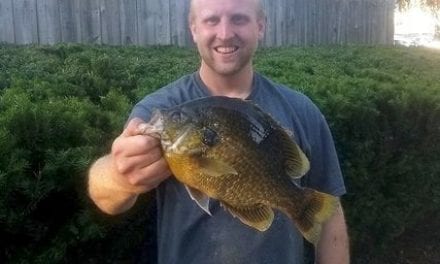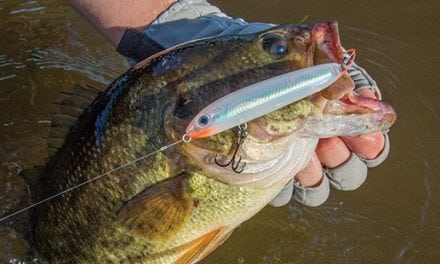
The immensity of Lake Winnipeg is impossible to comprehend if you’ve not seen it for yourself. Stretching 271 miles from north to south, and nearly 70 miles at its widest, this vast vestige of the Ice Age covers nearly 9,120 square miles—roughly 4% of Manitoba’s total surface area—making it the world’s 10th largest freshwater lake.
Lake Winnipeg’s north basin is larger and somewhat deeper than its south basin, but it’s in the south basin—specifically the southern portion of the south basin—where ice anglers come to catch the lake’s famous “greenback” walleyes. The beautiful emerald sheen that’s unique to these fish comes from the limestone deposits upon which the lake sits. But it’s not the only thing that’s special about Winnipeg’s walleyes; their average size is nothing short of incredible.
In fact, it’s a pretty safe bet that more double-digit walleyes have been caught on Lake Winnipeg than on any other body of water. A 34-inch fish, caught in 2015 and estimated to have weighed 15 pounds, shares the top spot in the National Fresh Water Fishing Hall of Fame’s Catch-And-Release World Record Book.
While commercial fishermen regularly ply the huge lake—winter and summer, little open-water sportfishing occurs. Besides being highly turbid and subject to algae blooms during the warm months, even the slightest wind can build huge waves on this shallow, featureless expanse of water.
Fishing promoter, former competitive angler and Team Northland member Chad Maloy has been traveling to Lake Winnipeg in search of giant greenbacks twice a winter for the past several years. During that time he’s seen the fishery’s popularity grow large enough to sprout a small guide/outfitter industry, and a quick Internet search bears it out. One benefit of using a guide is that they are in tune with where the schools of walleyes have been. Many anglers, however, still prefer the DIY approach, he says, and are very successful in their fishing—especially those who have been to the lake before, or are in the company of an experienced angler.
First-timers, though, will benefit from heeding some pre-trip insights from a veteran.
 1. First and foremost, “be prepared,” he says. The weather in Manitoba can be harsh in the winter. Travel in pairs or small groups in case someone breaks down or gets stuck. When the temps are 30 below zero for a few days in a row things break. Also, make sure to have back-ups for your GPS (a necessity when you can easily travel out of sight of land). Download the Navionics USA & Canada app on your cell phone; it could save your life. Finally, bring extra batteries for your phone, hand-held GPS and other important devices.
1. First and foremost, “be prepared,” he says. The weather in Manitoba can be harsh in the winter. Travel in pairs or small groups in case someone breaks down or gets stuck. When the temps are 30 below zero for a few days in a row things break. Also, make sure to have back-ups for your GPS (a necessity when you can easily travel out of sight of land). Download the Navionics USA & Canada app on your cell phone; it could save your life. Finally, bring extra batteries for your phone, hand-held GPS and other important devices.
Lake Winnipeg’s southern tip is just an hour’s drive from the city of Winnipeg, and during the summer months its beautiful sandy beaches attract tourists from far and wide. The story is different during the winter. “This isn’t like Lake of the Woods,” he says. “You don’t have big tourist towns that are open in winter. There are no resorts, rentals or plowed roads on the lake; just a handful of guides who cater to ice anglers. It’s somewhat primitive.”
Anglers can use the Internet to find lodging in Winnipeg, Scanterbury and elsewhere during the winter, but he recommends making arrangements well in advance of the trip. Maloy typically headquarters in Scanterbury and fishes along the eastern shore because access points at Patricia Beach Provincial Park, Balsam Harbour and Balsam Bay are a convenient drive from his hotel.
The lake itself is virtually void of identifiable underwater structure. Moving a mile across the ice might result in a depth change of just a few inches to a foot. There are no spot-on-a-spot areas. The fish here are very nomadic and are basically chasing schools of emerald shiners around the lake.
“It can be different from year to year,” says Maloy. “There have been times when we started fishing and never had to move—we stayed put and let the fish come to us. On other occasions, we had to work hard; the fishing was lights-out for a half-hour or so, then just died completely. We’d move a couple hundred yards, pop more holes and be into fish for 30 or 40 minutes, then had to start all over again.
“From time to time the Red River belches dirty water into Lake Winnipeg. If the water is very turbid, we like to move until we can get into water with better visibility. It doesn’t need to be gin-clear, but the fishing is better when walleyes can see their prey.”
If you can’t find an active school, keep moving until you intercept them and make contact, he explains. That can mean drilling lots of holes. Given the size of the lake, some anglers won’t even consider moving less than a mile at a time in pursuit of active walleyes, but that’s a matter of personal style.
The one exception here, Maloy adds, is where you find a pressure ridge, or ice heave, that forms when the ice expands and contracts. Pressure ridges allow light to penetrate and also for fresh water and oxygen to enter from above. “Baitfish like to use the structure below the ice heave as protection from the predators, and the walleyes can often be found right behind. It’s not uncommon to see fishermen lined up along a ridge for a couple of miles,” he says.
“Regarding techniques, Lake Winnipeg ice fishing is different from anywhere else,” says the angler, “and it’s really changed people’s thoughts on how you can catch fish.” Over the past several years, he explains, fishermen have refined the use of lipless rattlebaits, using them to attract walleyes from long distances in the clear, milky-green water.
“We refer to it as ‘hog calling,’” he says. “We rip the lure aggressively—touching the bottom and giving it a hard 3-foot rip. I’ll slow down when I see walleyes on sonar. You can fish two lines on Winnipeg, so I actually like to have a couple of rods ready; one with a horizontal presentation—a Rippin’ Shad—and one with a vertical presentation, like a Buck-Shot® Rattle Spoon or Macho Minnow tipped with a salted minnow head.”
He recommends using the 5/8-ounce Rippin’ Shad in Glo Tiger Shrimp, Glo Firetiger, Gold Black or Glo White Tiger, along with a 3/8- to ½-ounce spoon that has some blue, silver or pink. “When the fish are really aggressive you can fish the Rippin’ Shad naked,” he says. “Other times you may need to tip the bottom hook with a minnow head or even a full minnow to entice a strike. In either case, I also like to rub a little scent on the lure for added attraction.
“If walleyes come in but won’t commit, you might have to throw a change-up with something that’s a little more subtle. That’s when you want to go with a spoon-and-minnow-head or a jig tipped with a salted shiner.”
His go-to jig is a 3/8-ounce Rock-It Jig with a whole shiner threaded on the shank with the hook point coming out of the baitfish’s side. “I like this jig because it has a very sharp hook and a long shank with a baitkeeper,” he says. “Hooked sideways, the shiner has a little more action when you jig it, plus it helps the jig glide.”
Maloy has two final pieces of advice. First, trust your sonar. “I’ve learned to have faith that my electronics are telling me the truth. Often I’ll see flickers on the Vexilar, but they’re not just random flickers—they’re baitfish swimming buy. At times the bait may be just under the ice and walleyes will use the ice to corral their prey. So, make sure you cover the entire water column from just below the ice to the floor of the lake.”
Lastly, bring enough auger for the job. “In January you might not need an extender for your power auger,” he says. “But in March you might need two extenders. It depends on the year, but we’ve had to drill through 3 to 5 feet of ice.”
Lake maps courtesy of Navionics. For more information, visit: Navionics.com
The post Lake Winnipeg, MAN appeared first on ODU Magazine-North America's #1 Digital Fishing Magazine.















